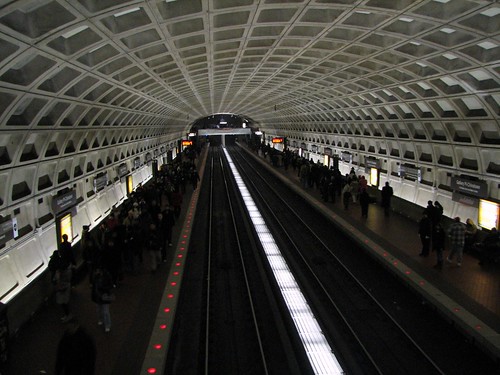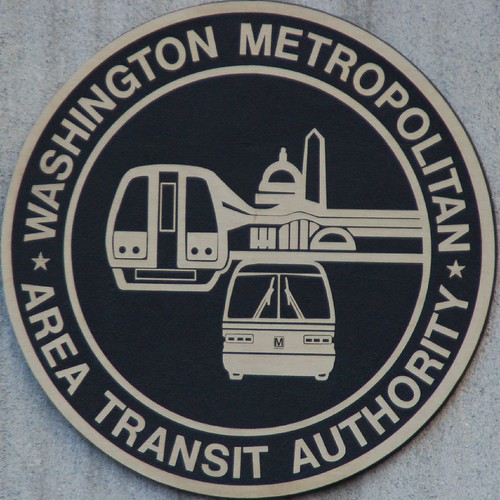An Open Letter to WMATA Chief, Mr. John Catoe – Are you really in touch with your customer? If not, please get in touch with me!
Hope all is well at your end. I am not doing so well, as you could see from the below paragraphs, after experiencing yet another bad commute on your trains, prompting me get on the computer and write you a letter at this ungodly hour. As a resident of the DC metro region, like millions of others, I have been commuting from a Maryland suburb to the District. Like many of your riders, I take the metro five days a week commuting on the Red Line and Green Line and almost always enjoyed the convenience of the commute. Except, there are those occasional days when I experience some discomfort, not one of the minor kind. The kind that makes you wonder how on earth a human being with a wee bit of logic can do such a dumb thing. The kind that defies logic! Oh, the human beings I am referring to are your train operators, who in my humble opinion are the primary carriers of your service-oriented message – Metro cares!

A Fitting Message Found On Metro!
Unfortunately, this evening was one of those days that I simply came home wondering if you or your staff will ever “get it”. I mean, get the message that the trains are actually operated for the very people who pay for a service that you offer. Let me walk you through what happened so that you will somehow try and make sense out of why such a thing can happen repeatedly.
After a long stressful day at work, I arrived at the Gallery Place/China Town station hoping to catch the Redline to Shady Grove that (usually) arrives just about 9:23PM. See, I told you I am a regular commuter, evident from the memorized train timings! Back to the story again. When I arrived at the platform towards Shady Grove, I saw a ton of people, most of whom were Hockey fans returning from the Verizon Center after watching the Frozen Four (the NCAA Mens Hockey Tournament Semi-Finals). As you can imagine, the platforms were pretty crowded and the train was approaching. Guess what! Today, your over enthusiastic train operator decided to give a lot of the Washingtonians a free workout on the platform and pulled way past the usual position. The 6 car train that arrived overshot the target and went past the point from where I normally board ( FYI, I normally board the middle doors on the 2nd last car). I am sure you can imagine the helter-skelter that ensued when this happens. The flood of people who were standing in positions where the last car will usually stop all started running with hopes of somehow making the train and getting home in a decent time.

Little do they know that the “wonderfully trained” operator of the train was in a great hurry to close the darn doors of the already crowded train that just arrived. Before the last passenger disembarked (an older lady) who was supposedly awaiting her turn to step out, your operator thought he waited long enough and proceeded to signal his intentions to close the door with a “Doors Closing” chime! Panic ensues as the people waiting to board rushed in and the poor old lady was trying to get off the train. Thank god she somehow made it out alive. But many of us who were waiting on the platform were left wondering what on earth could push a your train conductor to close the doors knowing all well there are a lot of people waiting to board the train. Oh you know what, there was still so much empty space inside the train cars as most of the passengers got off at the station in question.
Now things got a little more interesting. After the doors chimed and only a four people have gotten in through that last set of doors in that last car. Mind you that the case was very similar in almost all the cars as far as the eye could see ( I am not too tall to see all the way to the other end of the train). With only four people inside and at least 60 people waiting outside to get in, the driver decided to show some courtesy and opens the door briefly to allow for a passenger whose bag was stuck half-way through the door as he got on the train. Let me ask you to guess how “brief” the window of opportunity was for that poor customer of yours to retrieve that bag? ONE SECOND, I kid you not!
Some of the passengers who got on the train, including a couple of Mr. Hercules types, summoned all the strength in the world to hold the set of doors that had one mission – SHUT/CLOSE! In the fight between man and machine (operated by a mad man who gets paid by these commuters), the men had a brief victory, which allowed a bunch of more people to get on the train. With swelling crowds on the platform and the next train arrival showing 12 minutes later, you can see the anxiety-laden faces of people go into further panic. This tug of war between your train operator (who lost his mind when he arrived at Gallery Place) and the brave commuters (who were hell bent on adding a few more people to your train cars to make it worth your while to operate them at a cost/benefit ratio that somehow can justify you next round of federal funding) continued for a few more minutes. As you see, we are simply trying to help you move more people in the limited amount of time we get to use your trains.
The story was the same when the train arrived at the next stop – Metro Center, which thankfully was not so crowded but the tug of war continued to happen with the bunch that was trying to get in. I am not sure how many of your customers returned home with bruises & scars that can rival those of a soldier fighting to save this country in a Iraq or Afghanistan. Unlike them, we are not trained to fight and have no “weapons” to protect from your agressive train operators. Somehow we all managed to get home without having any major casualties in the war on Metro train this evening.
Well, this is just a sample from a day that is not very unusual. I have seen this happen many times in the past and I witnessed and participated in this today. Let me tell you that I do enjoy those days when you get some courteous operators who are patient enough to wait for the customers to board and show up for work with an attitude that says “customer is my god”. If you really like to hear this, I am a transportation expert myself (hence the name TransportGooru) and I am here to offer you a friendly tip or two — purely from an expert/customer point of view. Let’s now discuss the “potential; solutions to this recurring problem:
1. Train your operators to understand that they work for people who pay to get around safely, not just swiftly. Safety is paramount for everyone involved – not just for the Metro operator who stands well shielded in his hardened aluminum cocoon.
2. Run more trains on days (not all day but at least at for a couple of hours before the games start and after they end) when you know there is a game or a major event at one of our area’s sport arenas/centers. This should be very easy to do by coordinating with the organizers of such events (Verizon Center, Nationals, etc). BTW, you guys did an amazing job during the Cherry Blossom Festival. Kudos!
3. Deploy your highly trained & poorly paid police officers who always help immensely in dealing with such issues. I have seen on many occasions people are lot more obedient and well behaved when the officers are on the platform during such “rush” hours after the game. They also help your train operators to understand that the passengers need time to get on the train. If this would be a surprise for you, the above mentioned situation never happened in all these years when I took the train when the police officers are standing next to the trains at Galley Place, regulating the flow of passengers into the vehicles. I think your officers have some “fear” of getting arrested when they see police, because they do their job pretty well without screwing up.
4. If you think all the above solutions are not good, for Pete’s sake add a couple of cars on trains that arrive that time. Make it an 8 car train so that we have more doors to board and we don’t have to run a marathon on the platform to get close to the train. I did learn today that you are going to run 8 car trains on Red and Green lines when a bunch of train cars get delivered. Its about time you did this as you realize we are an active bunch in the DC area and there is always something to do around the town. We consider you to be the best option to get around from point A to point B, without polluting the environment or making some petro-terrorist nation richer by shelling for gasoline to drive our sexy cars into the City.
5. If possible, conduct a psychiatric evaluation of your current train operators, all of them, and re-train those who are borderline psychotic/neurotic. Before they injure someone or mangle some human body part, they be told that it is inappropriate to operate a vehicle in the above described manner. If it does not change, you may very soon have to print the following message on your Tickets: WARNING: RIDING METRO IS INJURIOUS TO HEALTH. WE ARE NOT RESPONSIBLE FOR YOUR LOSSES OR BODILY HARM WHILE ON THE METRO SYSTEM BECAUSE WE DON’T KNOW WHAT WE ARE DOING IN OUR JOBS.
6. Your hiring and training policies need to be revisited if the situation persists or deteriorate any further (which is highly unlikely as I already saw your staff hit the rock-bottom this evening with such appalling behavior. It can’t get any worse than what it is now).
7. The final suggestion: If you can’t fix it, just accept the failure and simply walk away. Some of your customers have done that – they are resigned to the fate they suffer in the hands of your egregious operators and have decided to move on to alternative modes of transportation (read as personal vehicles a.k.a. cars, mopeds, bicycles) and happily driving around polluting the air that you and your children breathe. If you want these people to return to your system, you have to correct these above mentioned deficiencies.. Or at least show them that you are making a sincere effort to do that.
If you still think none of the above suggestions are agreeable and you would still like to justify what your operator did is the right thing and there was a very good reason for doing so, please feel free to call me and explain what that reason would be. Because, I am already close to being “insane” trying to find a logic/reason for how a train/system could be operated in this fashion. Where I grew up, such a thing would be STOPPED and REEVALUATED COMPLETELY BEFORE IT IS DEEMED SUITABLE FOR SAFE OPERATION.
Before you tout the safety records of your system in yet another forum and plead your case for additional funding, I recommend you to prove to the general public that you and your staff are capable of running a system safely, smoothly and efficiently. Safety doesn’t always mean prevention of fatalities. It can also be interpreted as prevention of loss (of limbs & other body parts) to your customers. It is a shame that no one has challenged you before and I am glad to do so with this open letter. Or may be it happened and you/your predecessors simply ignored it.
Above all, you have to understand that all your good deeds may simply be ignored when a passenger on your system experiences something so disastrous of this kind. You and your staff are working hard all year and try to project a positive image to our city’s visitors and residents. But the actions of a dumb few in your crew negate all the good things you accomplish or try to accomplish within your means.
Alright! I probably sucked away a good chunk of your time reading this letter (which by now qualifies for the world’s longest complaint letter ever). Now, I’ll allow you to get back to fixing things around the Metro. In the meanwhile, if any of the above mentioned items or issues are hard to understand or difficult to reason with, please feel free to write to me. I’ll be glad to spend a couple of my hours to visit you and chat with you (very cordially, as you seen above) over a cup of coffee. Of course, I’ll pay for your coffee too and show our loyalty and generosity towards someone who has a keen interest in our commutes a pleasant one!
Look forward to hear from you soon. Take care, and enjoy a wonderful weekend!
Sincerely,
TransportGooru@gmail.com
(Signed on behalf of the all the suffering metro riders)
P.S: Apologies for the erratic spelling and any/all grammatical flaws you may have encountered. It is too late to proof-read but I am sure you are a smart man who is capable of looking past the mistakes and understand the “gist” of the letter, which is: Your service sucks! Help us, please!









